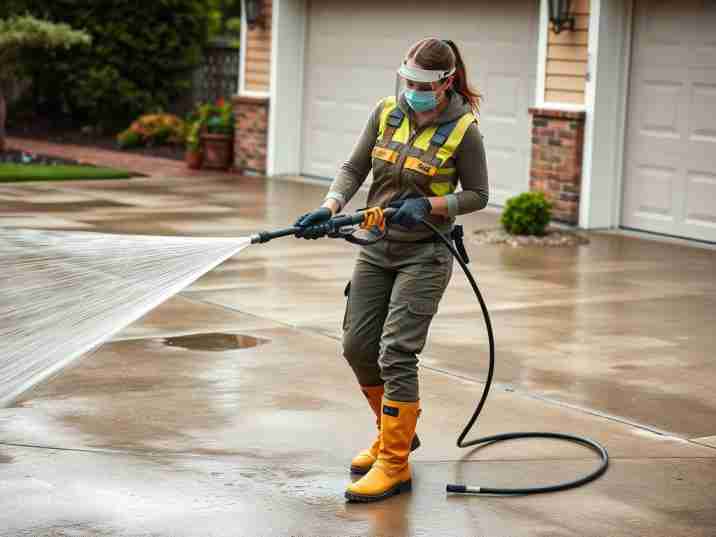In today’s world, where environmental sustainability is a growing concern, industries and individuals alike are seeking ways to reduce their ecological footprint. Power washing, a highly effective method for cleaning surfaces like driveways, decks, and buildings, has traditionally been associated with high water usage and chemical runoff. However, advancements in technology and practices have paved the way for eco-friendly power washing solutions that minimize environmental impact while delivering exceptional results.
This article explores how eco-friendly power washing works, its benefits, and actionable steps you can take to clean your property without harming the environment. Whether you’re a homeowner, business owner, or professional cleaner, adopting sustainable practices ensures that your cleaning efforts align with modern environmental standards.
1. Understanding the Environmental Impact of Traditional Power Washing
Before delving into eco-friendly alternatives, it’s important to understand why traditional power washing methods can be harmful to the environment:
A. Excessive Water Usage
Power washing typically requires large volumes of water—up to several gallons per minute. In regions facing water scarcity, this level of consumption can strain local resources and contribute to drought conditions.
B. Chemical Runoff
Many conventional power washing detergents contain harsh chemicals, such as bleach, phosphates, or chlorine-based compounds. When these substances wash away into storm drains, they can contaminate rivers, lakes, and groundwater, harming aquatic life and ecosystems.
C. Soil Erosion and Habitat Disruption
High-pressure water streams can disturb soil, vegetation, and nearby habitats, especially if proper precautions aren’t taken. This disruption can lead to erosion, loss of topsoil, and damage to plant roots.
D. Energy Consumption
The equipment used in power washing often relies on fossil fuels, contributing to greenhouse gas emissions. While electric-powered machines are becoming more common, many professionals still use gas-powered units, which further exacerbate carbon footprints.
By addressing these issues through eco-conscious practices, we can make power washing a greener and more responsible choice.
2. What Is Eco-Friendly Power Washing?
Eco-friendly power washing refers to the use of environmentally safe techniques, equipment, and cleaning agents to achieve thorough cleaning without compromising the planet. It combines innovative technologies with sustainable practices to reduce water waste, eliminate harmful chemicals, and protect surrounding ecosystems.
Key components of eco-friendly power washing include:
- Biodegradable Cleaning Solutions: Non-toxic, plant-based detergents that break down naturally without polluting water sources.
- Water Recycling Systems: Equipment designed to capture and reuse wastewater, minimizing overall consumption.
- Low-Pressure Techniques: Methods like soft washing that use lower pressure settings to conserve water and prevent surface damage.
- Energy-Efficient Machinery: Electric or battery-operated power washers that reduce reliance on fossil fuels.
These strategies not only benefit the environment but also enhance the safety and longevity of cleaned surfaces.
3. Benefits of Eco-Friendly Power Washing
Adopting eco-friendly power washing practices offers numerous advantages for both property owners and the planet. Here’s a closer look at the key benefits:
A. Reduced Water Waste
Traditional power washing can consume hundreds of gallons of water during a single session. Eco-friendly systems incorporate water-saving features, such as adjustable nozzles and recycling mechanisms, to significantly cut down on usage. For example:
- Adjustable Nozzles: Allow operators to control water flow based on the task, ensuring efficient use.
- Recycling Systems: Capture runoff water, filter out debris, and reuse it for subsequent cleaning tasks.
B. Protection of Local Waterways
Using biodegradable detergents eliminates the risk of toxic chemicals entering storm drains and contaminating local water bodies. These eco-friendly solutions are formulated to degrade quickly and safely, posing no threat to fish, plants, or other aquatic organisms.
C. Improved Air Quality
Switching to electric or battery-powered equipment reduces air pollution by eliminating exhaust fumes. This is particularly beneficial in urban areas, where air quality is already compromised by vehicle emissions and industrial activity.
D. Enhanced Safety for People and Pets
Non-toxic cleaning agents are safer for humans, pets, and wildlife. Unlike traditional chemicals, which can cause skin irritation, respiratory issues, or poisoning, eco-friendly products are gentle yet effective. This makes them ideal for households with children, pets, or sensitive individuals.
E. Long-Term Cost Savings
While eco-friendly equipment and solutions may have higher upfront costs, they often result in long-term savings. Reduced water bills, fewer repairs due to gentler cleaning methods, and extended equipment lifespans contribute to a better return on investment.
F. Positive Brand Image (for Businesses)
For commercial properties, adopting eco-friendly practices enhances brand reputation and attracts environmentally conscious customers. Companies that prioritize sustainability demonstrate social responsibility, fostering trust and loyalty among clients.
4. Steps to Implement Eco-Friendly Power Washing
If you’re ready to embrace eco-friendly power washing, here are practical steps to get started:
A. Choose Biodegradable Cleaning Agents
Select detergents labeled as “biodegradable,” “non-toxic,” or “eco-friendly.” Look for certifications from reputable organizations, such as the EPA’s Safer Choice program or Green Seal. These products are free from harmful ingredients and designed to decompose naturally after use.
B. Invest in Water-Efficient Equipment
Modern power washers come equipped with features that reduce water consumption. For instance:
- Variable Pressure Settings: Enable users to adjust the force of the water stream based on the surface being cleaned.
- Closed-Loop Systems: Recycle wastewater for reuse, drastically cutting down on fresh water requirements.
C. Opt for Low-Pressure Techniques
Soft washing is an excellent alternative to traditional high-pressure methods. By using lower pressure combined with specialized detergents, soft washing effectively cleans delicate surfaces like stucco, vinyl siding, and painted walls without causing damage. It also uses less water and energy compared to standard power washing.
D. Use Electric or Battery-Powered Machines
Transitioning to electric or battery-operated power washers reduces dependence on gasoline and lowers carbon emissions. These machines are quieter, produce zero exhaust fumes, and are increasingly affordable thanks to technological advancements.
E. Implement Proper Waste Management
To prevent contamination, always dispose of wastewater responsibly. If possible, use containment systems to collect runoff and filter out debris before releasing it into municipal drainage systems. Some companies even partner with wastewater treatment facilities to ensure proper handling.
F. Educate Clients and Employees
If you run a power washing business, educate your team about the importance of sustainability and train them in eco-friendly techniques. Similarly, inform clients about the benefits of green cleaning practices to encourage adoption.
5. Common Misconceptions About Eco-Friendly Power Washing
Despite its growing popularity, some misconceptions persist about eco-friendly power washing. Let’s address these myths:
A. Myth: Eco-Friendly Products Aren’t Effective
Reality: Modern eco-friendly detergents are just as effective—if not more so—than traditional chemicals. Advances in formulation technology have resulted in powerful, plant-based cleaners that tackle tough stains without harming the environment.
B. Myth: It Costs Too Much
Reality: While initial investments may be slightly higher, the long-term savings from reduced water usage, fewer repairs, and improved efficiency offset the costs. Additionally, government incentives and rebates for sustainable practices can further reduce expenses.
C. Myth: High Pressure Is Necessary for Deep Cleaning
Reality: Soft washing and low-pressure techniques are equally capable of removing dirt, grime, and organic growth. They simply require the right combination of detergent and technique to achieve optimal results.
6. Tips for Homeowners and Businesses
Whether you’re managing a residential property or running a business, here are additional tips to maximize the eco-friendliness of your power washing efforts:
A. Schedule Regular Maintenance
Preventative cleaning reduces the need for intensive treatments later on. Regular maintenance keeps surfaces free of buildup, minimizing water and detergent usage over time.
B. Partner with Certified Professionals
When hiring a power washing service, choose companies certified in eco-friendly practices. Ask about their equipment, cleaning agents, and waste management procedures to ensure alignment with sustainability goals.
C. Explore DIY Options
For small projects, consider renting or purchasing eco-friendly power washing equipment. Many manufacturers now offer compact, user-friendly models suitable for homeowners.
Conclusion
Eco-friendly power washing represents a significant step forward in balancing cleanliness with environmental stewardship. By adopting sustainable practices, such as using biodegradable detergents, conserving water, and leveraging energy-efficient equipment, we can achieve pristine results without compromising the health of our planet.
As awareness grows and technology advances, eco-friendly power washing will continue to gain traction as the preferred method for maintaining clean, attractive properties. Whether you’re a homeowner looking to preserve your outdoor space or a business aiming to enhance your corporate image, embracing green cleaning practices ensures a brighter future for generations to come.
Take the initiative today—choose eco-friendly power washing and join the movement toward a cleaner, healthier world!






